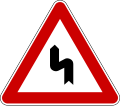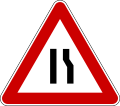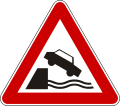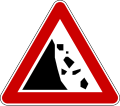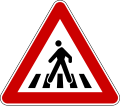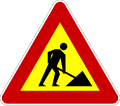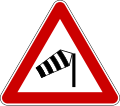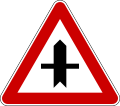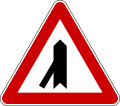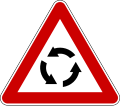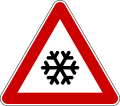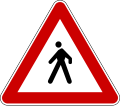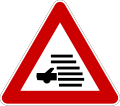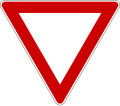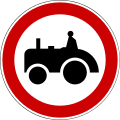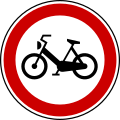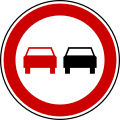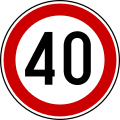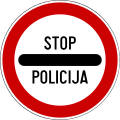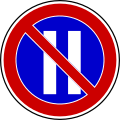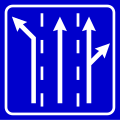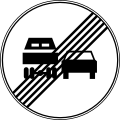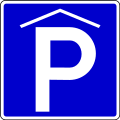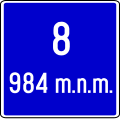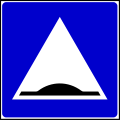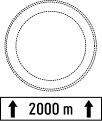Top Qs
Timeline
Chat
Perspective
Road signs in Montenegro
From Wikipedia, the free encyclopedia
Remove ads
Road signs in Montenegro are regulated in the Ordinance on Traffic Signals (Pravilnik o saobraćajnoj signalizaciji).[1]

Road signs in Montenegro follow the 1968 Vienna Convention on Road Signs and Signals, and the former Yugoslav standard road signs, used by the successor states of SFR Yugoslavia. Since Serbia and Montenegro were one state from 1992 to 2006 after the breakup of Yugoslavia, road signs in Montenegro are mostly similar to Serbian ones, except that the inscriptions are only written in Latin script. Following Montenegro's declaration of independence in 2006, the country's own road sign standard was adopted. With the adoption of the Constitution of Montenegro in 2007, in which the newly formed Montenegrin was promoted as an "official language", all public inscriptions, including road signs, began to be written in Latin script.[2] Despite the equality of the Cyrillic and Latin alphabets in Montenegro, as stated in the country’s Constitution, inscriptions on road signs are written exclusively in Latin script.
The SNV typeface is used on Montenegrin road signs.
The former Yugoslavia had originally signed the Vienna Convention on Road Signs and Signals on November 8, 1968 and ratified it on June 6, 1977.[3] Yugoslavia formerly used a yellow background on warning signs. After Montenegro declared its independence, the country succeeded to the Vienna Convention on October 23, 2006.
Remove ads
Warning signs
- I-1
Left curve - I-1.1
Right curve - I-2
Double curve, first at left - I-2.1
Double curve, first at right - I-2.2
Series of dangerous twists - I-3
Steep uphill - I-4
Steep downhill - I-5
Road narrows - I-5.1
Road narrows on left - I-5.2
Road narrows on right - I-6
Mobile bridge - I-7
Quayside - I-8
Bumpy road - I-9
Potholes - I-10
Traffic-calming bumps - I-11
Slippery roads - I-12
Loose chippings - I-13
Rockfall - I-13.1
Rockfall - I-14
Pedestrian crossing - I-15
Children area - I-16
Cyclists crossing - I-17
Domestic animal crossing - I-18
Wild animal crossing - I-19
Roadworks - I-20
Vertical traffic light - I-20.1
Horizontal traffic light - I-21
Low-flying aircraft - I-22
Crosswinds from left - I-22.1
Crosswinds from right - I-23
Bidirectional road traffic - I-24
Tunnel - I-25
Other hazards - I-26
Intersection with right-priority rule - I-27
Intersection on a priority road with a non-priority road - I-28
Intersection on a priority road with a non-priority road from left - I-28.1
Intersection on a priority road with a non-priority road from right - I-29
Merging traffic from left - I-29.1
Merging traffic from right - I-30
Roundabout - I-31
Tram crossing - I-32
Gated level crossing - I-33
Non-gated level crossing - I-34
Crossbuck - I-34.1
Crossbuck - I-35
Distance-panels for gated level crossing - I-36
Distance-panels for non-gated level crossing - I-37
Dangerous shoulder - I-38
Traffic queues likely - I-39
Ice on road - I-40
Accident - I-41
Pedestrians on the road - I-42
Fire danger - I-43
Fog
Remove ads
Order signs
Prohibitory signs
- II-1
Give way - II-2
Stop - II-3
Forbidden for road vehicles - II-4
No entry - II-5
Forbidden for motor vehicles, except solo motorcycles - II-6
Forbidden for buses and coaches - II-7
Forbidden for HGVs (lorries/trucks) - II-8
Forbidden for water-pollutants - II-9
Forbidden for explosive goods - II-9.1
Forbidden for dangerous goods - II-10
Forbidden for trailers - II-10.1
Forbidden for articulated vehicles - II-11
Forbidden for agricultural vehicles - II-12
Forbidden for motorcycles - II-13
Forbidden for mopeds - II-14
Forbidden for bicycles - II-15
Forbidden for electric scooters - II-16
Forbidden for horsecarts - II-17
Forbidden for human-powered vehicles - II-18
Forbidden for pedestrians - II-19
Forbidden for all motor vehicles - II-19.1
Forbidden for motor vehicles, motorcycles, and horsecarts - II-19.2
Forbidden for buses, coaches, agricultural machinery and horsecarts - II-20
Width limit - II-21
Height - II-22
Maximum weight - II-23
Maximum weight per axles - II-24
Maximum length - II-25
Safe distance - II-26
No left turn - II-26.1
No right turn - II-27
No U-turn - II-28
No overtaking - II-29
No overtaking for HGVs and buses - II-30
Speed limit - II-31
Honking forbidden - II-32
Customs - II-32.1
Police - II-32.2
Toll - II-33
Yield to oncoming traffic - II-34
No stopping - II-35
No parking - II-36
No parking on odd days - II-36.1
No parking on even days
Mandatory signs
- II-37
Minimum speed limit - II-38
Snow chains mandatory - II-39
Bike path - II-40
Pedestrian path - II-41
Pedestrian and bike path - II-41.1
Pedestrian and bike path - II-42
Trail for riders - II-43
Proceed straight - II-43.1
Turn right - II-43.2
Turn left - II-43.3
Turn left ahead - II-43.4
Turn right ahead - II-44
Proceed straight or turn left - II-44.1
Proceed straight or turn right - II-44.2
Turn left or right - II-45
Pass onto right - II-45.1
Pass onto left - II-45.2
Pass either side - II-46
Roundabout
Remove ads
Information signs
- III-1
Priority over oncoming traffic - III-2
One-way street - III-2.1
One-way street - III-3
Priority road - III-4
End of priority road - III-6
Pedestrian crossing - III-8
Underground or overground pedestrian passage - III-9
Dead end - III-10
The road of movement of the vehicle to the intersection where it is forbidden to turn left - III-11
Uses of lanes at an intersection - III-12
End of overtaking prohibition - III-13
End of overtaking by trucks prohibition - III-14
End of speed limit - III-15
End of minimum speed limit - III-16
End of using horns prohibition - III-17
End of snow chains mandatory - III-18
End of bike path - III-19
End of pedestrian path - III-20
End of pedestrian and bike path - III-20.1
End of pedestrian and bike path - III-21
End of trail for riders - III-22
End of previous prohibitions - III-23a
European route number - III-23b
National route number - III-24
Marker of the section of the county road - III-25
Motorway - III-26
End of motorway - III-27
Expressway - III-28
End of expressway - III-29
Locality - III-30
End of locality - III-31
Built-up area - III-32
End of built-up area - III-33
No parking zone - III-34
End of no parking zone - III-35
Parking - III-35.1
Parking garage - III-36
Parking time limit - III-36.1
Park and ride - III-37
Hospital - III-38
First aid - III-39
Breakdown service - III-40
Telephone - III-41
Petrol station - III-42
Hotel or motel - III-43
Restaurant - III-44
Cafe - III-45
Park - III-46
Camping for tents - III-47
Camping for caravans - III-48
Camping for tents and caravans - III-49
Vila - III-50
Road assistance - III-51
Fire extinguisher - III-52
Bus stop - III-53
Tram stop - III-54
Airport - III-55
Port - III-56
Information - III-56.1
Radio station - III-57
Taxi - III-58
Toilet - III-59
Passability of the road - III-60
Serpentine number - III-61
Bridge - III-62
Tunnel - III-65
Police station - III-66
Recommended speed limit - III-67
Street sign - III-68
Chevrons - III-68.1
Chevrons - III-68.2
Chevrons - III-68.3
Chevrons - III-69
Lane for buses - III-70
End of lane for buses - III-71
Beginning of traffic lane - III-72
End of traffic lane - III-73
Third lane - III-74
End of third lane - III-75
Emergency stopping lane - III-77
Maximum speed limit on the roads in Montenegro - III-78
Pedestrian zone - III-79
End of pedestrian zone - III-80
Speed limit zone - III-81
End of speed limit zone - III-82
Bump - III-83
Children on the road - III-84
Living street - III-85
End of living street - III-86
School zone - III-87
End of school zone - III-88
Alternating passing of vehicles - III-89
Intermittent passing of vehicles - III-93
Pay toll - III-94
Toll collection facility - III-95
Wrong way (Pogrešan smjer) - III-96
Emergency exit - III-96.1
Emergency exit - III-97
Distance to the emergency exit - III-97.1
Distance to the emergency exit
Remove ads
Information signs for traffic management
- III-201
An intersection - III-201.1
A roundabout intersection - III-202
Lane change with settlement directions - III-203
Arrow signpost - III-204
Road sign board - III-205
Direction confirmation - III-206
Pre-signaling of directions on the Highway - III-207
Signpost for the exit - III-210
Countdown beacon (100 m) - III-210
Countdown beacon (200 m) - III-210
Countdown beacon (300 m) - III-211
Exit sign board (expressways) - III-211.1
Exit sign board (motorways) - III-212
Distance to junction - III-212.1
Distance to junction
Remove ads
Tourist signs
- III-401
Expression of welcome when entering the country - III-401.1
Greeting when leaving the country - III-402
Expression of welcome when entering the territory of the municipality - III-403
Expression of welcome when entering other destinations - III-404
Expression of welcome when entering the thematic scenic route - III-405
Tourist information board - III-406
Scenic route - III-407
Tourist information board - III-408
Tourist direction sign - III-409
Tourist signboard - III-410
Tourist signboard in a settlement - III-410.1
Tourist signboard in a settlement - III-411
Tourist sign boards - III-411.1
Tourist sign boards
Remove ads
Additional signs
- IV-1
Distance - IV-2
Distance - IV-3
Distance - IV-3.1
Distance - IV-4
Additional distance - IV-4.1
Additional distance - IV-5
Parking method - IV-5.1
Parking method - IV-5.2
Parking method - IV-5.3
Parking method - IV-5.4
Parking method - IV-5.5
Parking method - IV-5.6
Parking method - IV-5.7
Parking method - IV-5.8
Parking method - IV-6
Priority road direction - IV-6.1
Stop ahead - IV-8
Side extension (of parking or stopping ban) - IV-8.1
Side extension (of parking or stopping ban) - IV-8.2
Side extension (of parking or stopping ban) - IV-8.3
Start - IV-8.4
Continue - IV-8.5
End - IV-9
Duration - IV-10
Number of dangerous turns - IV-11
Painting stripes on the road - IV-12
Speed bump - IV-13
Elderly people - IV-14
Directions to parking - IV-15
Road closed due to smog - IV-16
Road conditions - IV-16.1
Road conditions - IV-16.2
Road conditions - IV-17
Vehicle categories - IV-18
Lateral distance - IV-19
Parking place for handicapped persons - IV-20
Limitation of the permitted maximum mass - IV-21
Accident - IV-22
Snowplow
Remove ads
See also
References
External links
Wikiwand - on
Seamless Wikipedia browsing. On steroids.
Remove ads



